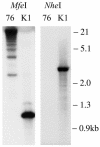Expression in a recombinant murid herpesvirus 4 reveals the in vivo transforming potential of the K1 open reading frame of Kaposi's sarcoma-associated herpesvirus
- PMID: 15280496
- PMCID: PMC479053
- DOI: 10.1128/JVI.78.16.8878-8884.2004
Expression in a recombinant murid herpesvirus 4 reveals the in vivo transforming potential of the K1 open reading frame of Kaposi's sarcoma-associated herpesvirus
Abstract
Murid herpesvirus 4 (commonly called MHV-68) is closely related to Kaposi's sarcoma-associated herpesvirus (KSHV) and provides an excellent model system for investigating gammaherpesvirus-associated pathogenesis. MHV-76 is a naturally occurring deletion mutant of MHV-68 that lacks 9,538 bp of the left end of the unique portion of the genome encoding nonessential pathogenesis-related genes. The KSHV K1 protein has been shown to transform rodent fibroblasts in vitro and common marmoset T lymphocytes in vivo. Using homologous recombination techniques, we successfully generated recombinants of MHV-76 that encode green fluorescent protein (MHV76-GFP) and KSHV K1 (MHV76-K1). The replication of MHV76-GFP and MHV76-K1 in cell culture was identical to that of MHV-76. However, infection of BALB/c mice via the intranasal route revealed that MHV76-K1 replicated to a 10-fold higher titer than MHV76-GFP in the lungs at day 5 postinfection (p.i.). We observed type 2 pneumocyte proliferation in areas of consolidation and interstitial inflammation of mice infected with MHV76-K1 at day 10 p.i. MHV76-K1 established a 2- to 3-fold higher latent viral load than MHV76-GFP in the spleens of infected mice on days 10 and 14 p.i., although this was 10-fold lower than that established by wild-type MHV-76. A salivary gland tumor was present in one of four mice infected with MHV76-K1, as well as an increased inflammatory response in the lungs at day 120 p.i. compared with that of mice infected with MHV-76 and MHV76-GFP.
Figures







References
-
- Beral, V., and R. Newton. 1998. Overview of the epidemiology of immunodeficiency-associated cancers. J. Natl. Cancer Inst. Monogr. 1998:1-6. - PubMed
-
- Blackman, M. A., E. Flano, E. Usherwood, and D. L. Woodland. 2000. Murine gamma-herpesvirus-68: a mouse model for infectious mononucleosis? Mol. Med. Today 6:488-490. - PubMed
-
- Blaskovic, D., M. Stancekova, J. Svobodova, and J. Mistrikova. 1980. Isolation of five strains of herpesviruses from two species of free living small rodents. Acta Virol. 24:468. - PubMed
-
- Chang, Y., E. Cesarman, M. S. Pessin, F. Lee, J. Culpepper, D. M. Knowles, and P. S. Moore. 1994. Identification of herpesvirus-like DNA sequences in AIDS-associated Kaposi's sarcoma. Science 266:1865-1869. - PubMed
Publication types
MeSH terms
Substances
LinkOut - more resources
Full Text Sources
Molecular Biology Databases

